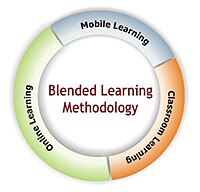What is educational design?
| Learning and Teaching in Practice | |
|---|---|
| Module 3: Teaching context and learning design | |
| Educational design | Introduction | What is educational design? | The rationale | Learning design roles | Methods and approaches | Summary |
Contents
What is educational design?
Educational design is a general term used to cover both curriculum design and learning design processes:
- Curriculum design
- Designing a programme or course. This involves a 'big picture' plan or scope rather than the details of what learners will be doing or study on any given day. Curriculum design (such as making substantial changes to a course or programme) generally requires consultation with colleagues in the team, other stakeholders and the quality assurance unit at your organisation.
- Learning design
- Designing smaller units of learning in greater detail, including specific learning and teaching activities and resources. Innovation with learning design does not usually require formal consultation and approval, although it is always a good idea to talk to others about your ideas, colleagues and students.
- NMIT definition of learning design
Learning Design refers to the process of explicitly designing learning activities, content, tools and supports to enable a learner to meet a specific learning goal. It also defines the process for ensuring that the learners’ experience of a course is consistent with the statements about learning, teaching and assessment in the programme regulations and related policies. A well-developed learning design rationale will inform programme design as well as course development.
Curriculum design
Curriculum design involves creating the 'big picture' plan of either a course or a programme - not the details of what learners will be doing or study on any given day, but the overall scope of the course. Generally, curricula are designed according to the organisation's strategic requirements. For example, at Otago Polytechnic, programmes must endorse the Maori Strategic Framework and strategies for blended learning and sustainability.
For a purely theoretical course, this may involve an analysis of the content that will be covered. Most vocational or applied courses are designed using a form of functional analysis - the course design focuses on what successful course graduates would be able to do (learning outcomes) at the end of the course. The course design will also include the content needed to allow these outcomes to be achieved.
Not all teachers need to be concerned with designing a course curriculum as (in many situations) the course they teach has already been designed and approved.
|
Emilia will need to design the curriculum as this is part of her role - the Public Health Policy course has not yet been designed. Drawing on her in-depth professional experience, Emilia carries out a detailed functional analysis technique:
|
|
Brett's task is a little different - he already has a curriculum but needs to review it. He'll probably need to draw on his own knowledge of current carpentry practice as well as feedback from his contacts in industry:
|
Assessment design
Summative assessment provides the means to see whether learners have met the specific learning outcomes.
Not all teachers need to be concerned with designing assessments as (in many situations) these already been designed and approved. But teachers are very likely to be involved in developing formative assessments as well as implementing summative assessments and (from time to time) reviewing and reworking them.
|
Having designed the learning outcomes for the course, Emilia can now move on to designing the summative assessments. She needs to design assessments which are valid - that is, they are closely matched to the learning outcomes. |
|
Having redesigned the learning outcomes for the course, Brett can now move on to redesigning the summative assessments. He will need to review the assessments to ensure they are valid - that is, that they closely match the revised learning outcomes. |
Learning design
Whereas curriculum design is concerned mostly with the big picture, the term learning design usually refers to the design of smaller units of learning. Often this starts by developing more specific learning objective and anticipated outcomes for each topic which fit within the 'big-picture' course learning outcomes. It also involves planning and preparing learning resources (content), interactions, activities and assessments to meet the needs of the learners and the course curriculum.
Face to face learning and teaching
Face-to-face learning (kanohi-ki-te-kanohi) may take many forms - from the 'traditional' one-to-many lecture involving primarily one-way transmission of information (didactic) to highly interactive and social approaches (experiential).
'Traditional' vocational courses in institutions such as polytechnics have normally relied primarily on face-to-face teaching and learning. But as well as sessions in a classroom or workshop or laboratory, practical classes are also held in work settings. For example, carpentry students at Otago Polytechnic build houses on site at the campus, and health students work in the community in homes and hospitals. Learners are expected to study in their own time outside the classroom - self-directed learning.
Distance learning courses are designed to accommodate students who are geographically or socio-economically unable to study on-campus. They tend to remove most of the face-to-face component (apart from occasional on-campus classes in 'blocks' - a day, a week etc.,) and rely on self-paced materials (printed, media or online) to guide learning. Depending on the design of the course, study may involve individual self-paced learning, or group-oriented learning (possibly in a learning community).
Technology-enhanced and blended learning

Otago Polytechnic, like many other institutions, has a strategic plan which explicitly focuses on the incorporation of technology to enhance learning and the use of blended approaches to better meet the needs of learners.
Platforms for technology-enhanced and blended learning (such as Moodle and other learning management systems) incorporate a range of tools for social interaction, both synchronous and asynchronous.
While social approaches to learning have become increasingly important, there are still contexts and situations where it is more appropriate for individual self-paced learning. Technology-enhanced self-paced learning requires well-designed resources and activities.
The technology may take many forms and incorporate a range of media. The technology may be a means of providing:
- learning resources with content for learners to view, such as web pages or videos.
- learning activities such as online discussion forums or collaborative wiki pages.
The incorporation of technology and blended approaches leads to a more complex learning environment and requires additional considerations for learning design:
- The wide range of types of technology-based learning resources requires more careful consideration in their choice and design.
Teachers with experience in a primarily face to face context will have developed skills in designing paper-based (print) learning materials. Designing and developing online resources (such as web-based text with photos, diagrams, video and audio) requires an extended set of knowledge and skills. - Technology-based learning activities are often different and more complex than traditional learning activities.
Teachers with experience in a primarily face to face context will have developed skills in designing class-room based learning activities. Designing and developing online learning activities (such as online discussion forums or collaborative wiki pages) requires an extended set of knowledge and skills.
|
|
In designing her course, Emilia will need to make some decisions on how technology-enhanced and blended learning approaches will be incorporated, as this is a key aspect of course delivery. A practical guide to providing flexible learning in further and higher education by Casey, J. & Wilson, P. (2005). |
|
Brett hasn't been asked to redesign how the course is delivered, so cannot make too many 'big-picture' decisions on how technology will be incorporated. However, he can consider how incorporating technology might enhance learning and teaching in the revised course. |

